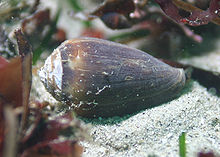- Conoidea
-
Conoidea 
A live Californiconus californicus, in situ, anterior end on the right Scientific classification Kingdom: Animalia Phylum: Mollusca Class: Gastropoda (unranked): clade Caenogastropoda
clade Hypsogastropoda
clade NeogastropodaSuperfamily: Conoidea
Fleming, 1822[1]Families See text
Conoidea is a superfamily of predatory sea snails, marine gastropod mollusks within the suborder Hypsogastropoda. This superfamily is a very large group of marine mollusks, estimated at about 340 recent valid genera and subgenera, and considered by one authority to contain 4,000 named living species (Puillandre et al. 2008).[2] This superfamily includes the turrids, the terebras (also known as auger snails or auger shells) and the cones or cone snails.[2] The phylogenetic relationships within this superfamily are poorly established. Several families (especially the Turridae), subfamilies and genera are thought to be polyphyletic.[2]
In contrast to Puillandre's estimate, Bandyopadhyay et al. (2008)[3] estimated that the superfamily Conoidea contains about 10,000 species. Tucker (2004) even speaks of 11,350 species group taxa commonly referred as turrids.. [4] 3000 recent taxa are potentially valid species. Little more than half of the known taxa are fossil species. Many species are little known and need more investigation to find their exact systematic place. [4]
The superfamily is known for its toxoglossan radula, which is used to inject powerful neurotoxins into its prey; within the superfamily there are four somewhat different varieties of radula. [5]
The radula types [6] are as folows:
- Type 1 Drilliidae type : five teeth in each row with comb-like lateral teeth and flat-pointed marginal teeth
- Type 2 Turridae type : two or three teeth in a row with the marginal teeth being of the duplex or wishbone form.
- Type 3 Pseudomelatomidae type : two or three teeth in a row with curved and solid marginal teeth.
- Type 4 hypodermic type : two hollow, enrolled, marginal teeth in each row with an absent or reduced radular membrane.
In 2011, a new classification of this superfamily was published by Bouchet et al.
Families
- Families and subfamilies within the superfamily Conoidea include according to Taylor, et al. 1993[7]
- Clavatulidae Clay, 1853
- Conidae Rafinesque, 1815
-
- Coninae - cone snails
- Clathurellinae
- Conorbiinae
- Mangeliinae
- Oenopotinae
- Raphitominae
-
- Drilliidae Olsson, 1964
- Pseudomelatomidae Morrison, 1964
- Strictispiridae McLean, 1971
- Terebridae Mörch, 1852 - auger shells
- Turridae H. Adams & A. Adams, 1853 (1838) - turrids
This same classification was accepted by Bouchet & Rocroi in 2005 [8]
- New classification (2011)
This classification was thoroughly changed by the publication in 2011 of the article Bouchet P., Kantor Yu.I., Sysoev A. & Puillandre N. (2011) A new operational classification of the Conoidea. Journal of Molluscan Studies 77: 273-308. The authors presented a new classification of the Conoidea on the genus level, based on anatomical characters but also on the molecular phylogeny as presented by Puillandre N., et al., 2008 [9]. They recognize fifteen families : Conidae, Terebridae, and the polyphyletic family Turridae resolved into 13 monophyletic families (containing 358 currently recognized genera and subgenera). The authors follow tentatively the classification for the family Conidae as presented by Tucker & Tenorio, 2009 [10] who divided the monospecific family Conidae into 82 genera. However there is no final opinion on this issue yet, as a new molecular phylogeny of the Conidae is in preparation. A number of genera within the Conoidea which could not be assigned to any family.
Recognized Families in the Conoidea (as of 2011):
- Clavatulidae
- Drilliidae
- Pseudomelatomidae
- Horaiclavidae
- Strictispiridae
- Terebridae
- Turridae
- Cochlespiridae
- Borsoniidae
- Mitromorphidae
- Clathurellidae
- Conidae
- Conorbidae
- Raphitomidae
- Mangeliidae
References
- ^ Fleming J. (June 1822). The philosophy of zoology, a general view of the structure, functions and classification of animals 2. Constable & Co., Edinburgh, 618 pp., Conidae is on the page 490.
- ^ a b c Puillandre N. et al. (2008). "Starting to unravel the toxoglossan knot: Molecular phylogeny of the “turrids” (Neogastropoda: Conoidea)". Molecular Phylogenetics and Evolution 47(3): 1122-1134. doi:10.1016/j.ympev.2007.11.007. PubMed
- ^ Bandyopadhyay P. K., Stevenson B. J., Ownby J.-P., Cady M. T., Watkins M. & Olivera B. M. (2008) "The mitochondrial genome of Conus textile, coxI–coxII intergenic sequences and Conoidean evolution". Molecular Phylogenetics and Evolution 46(1): 215-223. doi:10.1016/j.ympev.2007.08.002.
- ^ a b Tucker, J.K. 2004 Catalog of recent and fossil turrids (Mollusca: Gastropoda). Zootaxa 682:1-1295.
- ^ Kantor, Yuri I.; Taylor (1991). "John D.". J. Mollus. Stud. 57 (1): 129–134. doi:10.1093/mollus/57.1.129. http://mollus.oxfordjournals.org/content/57/1/129.extract. Retrieved 27 August 2011.
- ^ Kantor, Yuri I.; Taylor (2000). "John D.". J.Zool.,Lond. 252: 251–262. http://www.sevin.ru/laboratories/Marine_Invertebrates/kantor/071_Kantor_Taylor_2000.pdf. Retrieved 27 August 2011.
- ^ Taylor J. D., Kantor Y. I. & Sysoev A. V. (1993). "Foregut anatomy, feeding mechanisms, relationships and classification of Conoidea (Toxoglossa) (Gastropoda)". Bull. Nat. Hist. Mus. (Zool.) 59: 125–169.
- ^ Bouchet P., Rocroi J.-P., Frýda J., Hausdorf B., Ponder W., Valdés Á. & Warén A. (2005). "Classification and nomenclator of gastropod families". Malacologia: International Journal of Malacology (Hackenheim, Germany: ConchBooks) 47 (1-2): 1–397. ISBN 3925919724. ISSN 0076-2997
- ^ Puillandre N., et al., 2008 " Starting to unravel the toxoglossan knot: molecular phylogeny of the “turrids” (Neogastropoda: Conoidea)". Molecular Phylogenetics and Evolution 2008;47:1122-1134
- ^ Tucker J.K., Tenorio M.J., "Systematic classification of Recent and fossil conoidean gastropods". Hackenheim, Germany: Conchbooks; 2009
Further reading
- Tucker, John K. (12 October 2004). "Catalog of Recent and fossil turrids (Mollusca: Gastropoda)". Zootaxa 682: 1–1295. http://www.mapress.com/zootaxa/list/list2004.html#October%202004.
- Kantor Y. I. & Taylor J. D. (2000). "Formation of marginal radular teeth in Conoidea (Neogastropoda) and the evolution of the hypodermic envenomation mechanism". Journal of Zoology 252(2): 251–262. doi:10.1111/j.1469-7998.2000.tb00620.x
Categories:- Neogastropoda
- Caenogastropoda stubs
Wikimedia Foundation. 2010.
